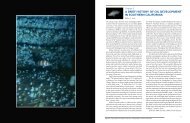checklist (pdf) - The Love Lab - University of California, Santa Barbara
checklist (pdf) - The Love Lab - University of California, Santa Barbara
checklist (pdf) - The Love Lab - University of California, Santa Barbara
Create successful ePaper yourself
Turn your PDF publications into a flip-book with our unique Google optimized e-Paper software.
Order Gadiformes<br />
Family Macrouridae — Grenadiers or Rattails<br />
Albatrossia pectoralis (Gilbert, 1892). Giant Grenadier or Small-eyed Rattail. To 180 cm (70.9 in) TL<br />
(Pakhorukov 2005). Okhotsk Sea (Tuponogov 1997) and northern Honshu, Japan to Bering Sea<br />
(Mecklenburg et al. 2002) to northern Baja <strong>California</strong> (Iwamoto in Cohen et al. 1990). Benthopelagic, young<br />
fish bathypelagic (Iwamoto and Stein 1974), at depths <strong>of</strong> 140–2,189 m (459–7,182 ft) (min.: Iwamoto in<br />
Cohen et al. 1990; max.: Pearcy et al. 1982). Originally in Macrurus, recently in Coryphaenoides.<br />
Caelorinchus scaphopsis (Gilbert, 1890). Shoulderspot Grenadier. To at least 34 cm (13.4 in) TL (Iwamoto<br />
in Cohen et al. 1990). Off northern <strong>California</strong> (41°14'N, 124°24'W; H<strong>of</strong>f 2002) to the Gulf <strong>of</strong> <strong>California</strong><br />
(Iwamoto and Schneider in Fischer et al. 1995). Benthopelagic at depths <strong>of</strong> 183–296 m (600–971 ft;<br />
Iwamoto in Cohen et al. 1990). Although the genus is <strong>of</strong>ten seen with spelling Caelorhynchus, the correct<br />
spelling is Caelorinchus (Eschmeyer 1998).<br />
Coryphaenoides acrolepis (Bean, 1884). Pacific Grenadier or Roughscale Rattail. To more than 87 cm<br />
(34.2 in) TL (Rass 1963). Sea <strong>of</strong> Okhotsk and Pacific <strong>of</strong>f Japan to southern Bering Sea and Aleutian<br />
Islands (Mecklenburg et al. 2002) to Isla Guadalupe, central Baja <strong>California</strong> (Miller and Lea 1972).<br />
Benthopelagic and bathypelagic, typically at depths <strong>of</strong> 600–2,500 m (1,968–8,202 ft; Iwamoto and Stein<br />
1974), reported as shallow as 35 m and 155 m (115 ft and 508 ft; Evermann and Goldsborough 1907)<br />
and as deep as 2,825 m (9,268 ft; Pearcy et al. 1982). Originally in Macrurus.<br />
Coryphaenoides anguliceps (Garman, 1899). To more than 50 cm (19.7 in) TL (Iwamoto in Cohen et al.<br />
1990). Southernmost Baja <strong>California</strong> and Gulf <strong>of</strong> <strong>California</strong> (Iwamoto and Schneider in Fischer et al.<br />
1995) to northern Chile (26°S; Sielfeld and Vargas 1996) and Islas Galápagos (Iwamoto in Cohen et al.<br />
1990). Benthopelagic, at depths <strong>of</strong> 722–2,418 m (2,369–7,933 ft; Iwamoto in Cohen et al. 1990).<br />
Coryphaenoides armatus (Hector, 1875). Abyssal Grenadier or Smooth Abyssal Grenadier. To 102 cm<br />
(40.2 in) TL (Iwamoto in Cohen et al. 1990). All oceans except Arctic; Japan Trench (Nakabo in Nakabo<br />
2002); southeastern Bering Sea and Pacific south <strong>of</strong> Aleutian Islands (Mecklenburg et al. 2002) to Chile<br />
(Pequeño 1989). Benthopelagic, typically at depths <strong>of</strong> about 2,000–4,300 m (6,562–14,107 ft; Wilson<br />
and Waples 1983) or more (“about 5,000 m”; SIO 04-26) in the North Pacific (Wilson and Waples<br />
1983), to 4,700 m (15,420 ft) in the Atlantic (Grey 1956, Moore et al. 2003); reported from shallower<br />
(282 m [931 ft; Grey 1956]) or greater (5,180 m [16,995 ft; Pearcy et al. 1982]) depths, but not verifiable.<br />
Originally in Macrurus.<br />
*Coryphaenoides capito (Garman, 1899). Bighead Grenadier. To 32.4 cm (12.8 in) TL (Iwamoto and<br />
Schneider in Fischer et al. 1995). Gulf <strong>of</strong> <strong>California</strong> (Iwamoto and Schneider in Fischer et al. 1995) to<br />
northern Peru (Chirichigno and Vélez 1998), including southern tip <strong>of</strong> Baja <strong>California</strong> (Iwamoto and<br />
Schneider in Fischer et al. 1995). Benthopelagic, at depths <strong>of</strong> 305–1,000 m (1,001–3,281 ft; Iwamoto and<br />
Schneider in Fischer et al. 1995).<br />
Coryphaenoides cinereus (Gilbert, 1896). Gray Rattail or Popeye Grenadier. To 56 cm (22 in) TL (Iwamoto<br />
and Stein 1974). Northern Japan and southern Sea <strong>of</strong> Okhotsk to Navarin Canyon, Bering Sea<br />
(Mecklenburg et al. 2002) to Monterey Bay, central <strong>California</strong> (H<strong>of</strong>f 1999). Benthopelagic, at depths <strong>of</strong><br />
225–2,832 m (738–9,291 ft; Allen and Smith 1988). Reported from trawl nets towed as deep as 3,480 m<br />
(11,417 ft), but in nonclosing nets which would allow fish to enter at any depth during retrieval <strong>of</strong> the<br />
net (Makushok 1970). Originally in Macrurus.<br />
Coryphaenoides filifer (Gilbert,1896). Filamented Rattail or Threadfin Grenadier. To 66.2 cm (26.1 in) TL<br />
(Iwamoto and Stein 1974). Sea <strong>of</strong> Okhotsk <strong>of</strong>f Hokkaido, Japan (Endo et al. 1994); southeastern Bering<br />
Sea and Aleutian Islands (Mecklenburg et al. 2002); northern British Columbia (G. E. Gillespie, pers.<br />
53




